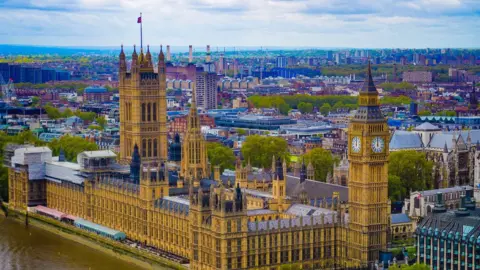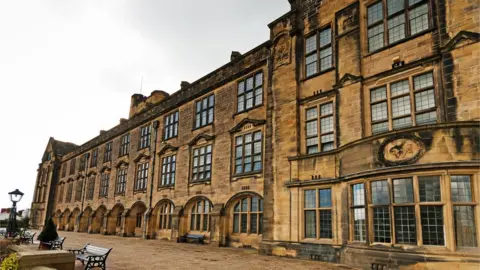Plans to cut number of Welsh MPs changed
 Getty Images
Getty ImagesVoters will have one last chance to give their views as commissioners revise plans to cut the number of Welsh MPs.
The number of MPs representing communities in Wales would be cut from 40 to 32 under proposals.
But changes have been made to the initial proposals, which will change the map of MPs' constituencies.
So what has changed in the Boundary Commission for Wales' plans? And what does it mean for voters?
Plans to redraw the parliamentary boundaries date back about a decade, when David Cameron was prime minister.
The commission has no power to set the number of MPs - which has already been decided by Parliament - and will not consider arguments around the number of constituencies.
There are significant changes that affect Barry and Cardiff, while much of the north Wales map has also been amended.
Under new Westminster rules each constituency proposed must contain between 69,724 and 77,062 registered voters.
The UK government says this will ensure people from all parts of the UK have equal representation in Parliament.
As a result England will receive an additional 10 MPs, while Wales loses eight.
That is because Wales has some of the smallest constituencies in the UK: on average they are smaller than those in England.
All constituencies will change from how they are currently drawn, with the exception of Ynys Mon, which has "protected status" and will have no changes to the Anglesey seat's name or boundaries.
What are the changes?
In Wales, 22 constituencies will be affected under changes to the initial plans.
Bangor will be included in a constituency called Bangor Aberconwy, rather than split across two constituencies, while a Clwyd East constituency would include parts of Delyn, Vale of Clwyd, and Clwyd West, including Ruthin.
Proposals for an expanded Alyn and Deeside constituency will be changed to include Flint, and there are changes to the boundaries of Wrexham.
Barry will be included in the Vale of Glamorgan - as it is now - instead of the initially proposed Barry, Cardiff South and Penarth constituency.
Plans for Cardiff have been revised. Instead of a Cardiff Central constituency a Cardiff East area will include the east ward of Trowbridge. Cathays will join Cardiff South and Penarth.
Bridgend constituency will be amended so it will include all of Bridgend town centre - which was initially split between two constituencies.

The new plans significantly revise boundaries planned around the west of Newport.
Instead of a Newport West and Caerphilly constituency, Newport West and Islwyn has been drawn up.
It will connect the city with the towns located in the valleys leading into the city.
The commission said the alternative had "garnered significant support" based on local ties and travel connections.
Caerphilly would be a standalone constituency, including Caerphilly town and some of the wards currently in Islwyn.
 Getty Images
Getty ImagesOther changes include revisions to boundaries in Carmarthen, Mid and South Pembrokeshire, Ceredigion Preseli, and Aberafan Porthcawl.
Nine constituency names have been altered.
Commissioners proposed to change the Brecon and Radnor seat, to Brecon, Radnor and Cwm Tawe, to better reflect the inclusion of council wards from the Swansea Valley.
These proposals come after more than 1,300 responses were made to the initial ideas. Final proposals will be presented to Parliament in July 2023.
The changes will affect plans for 96 Senedd politicians, and the new map will be used to design the constituencies for the Welsh Parliament from 2026 if the reforms go ahead.
Despite opposition received to the splitting of Cynon Valley, the boundary commission did not significantly change the plan. Much of the constituency will join Merthyr Tydfil.
What is the reaction?
The overall plans to cut the number of representatives at Westminster have been controversial for some time. One political party criticised plans to include Swansea Valley with more rural areas.
A Plaid Cymru spokeswoman said: "The decision by Westminster to reduce the number of constituencies so drastically has made this a difficult process for the Boundary Commission, and we thank them for their work.
"Lumping post-industrial communities like Cwm Tawe with rural areas like Brecon and Radnor makes no sense, and highlights the absurdity of the scale of the changes imposed by Westminster."
Labour thanked the commission, but said: "As we have made clear, we regret that Wales will lose 8 seats in the review."
Deputy commission chair Mrs Justice Jefford said the exercise had received 1,367 written and 81 oral representations on the initial proposals.
"As a result, the commission has revised the initial proposals. It has proposed changes, often significant changes, to 22 of the 32 proposed constituencies."
The commission is consulting on new seats for Westminster - but plans to reform the Senedd and increase the number of the Senedd members mean it will be used as the basis for the Welsh Parliament's planned new voting system.
The remaining 32 constituencies will be paired, with six politicians elected under a list system in each of the remaining 16 constituencies.

- FIGHT FOR YOUR RIGHTS: The Welsh consumer show fighting for YOUR rights
- WALESCAST: What's happening in the world of Welsh politics?

